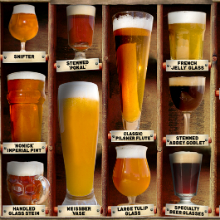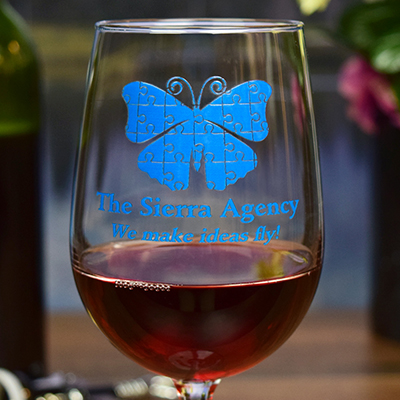Beer Styles by Name
Beer Styles by Name

A
Abbey Ale : A strong beer brewed traditionally by Belgian abbeys for the brothers to enjoy as "liquid bread" during their Lenten fasting.
Ale : A generic name for beers produced by top fermentation. Generally, ales are higher in alcohol, heartier, and darker than lagers, which are brewed by bottom fermentation.
Altbier : A traditional style of beer brewed mainly in Dusseldorf. The German word alt means old and refers to the traditional method of top fermentation. Alt beers are dark, copper colored, brewed from dark malts, well hopped.
B
Bamberg Beer : See Rauchbier
Barley Wine : A top-fermented beer of unusually high, wine-like, alcohol content. Copper-colored or dark brown, strongly flavored, fruity, sometimes fermented with wine or champagne yeast.
Beer : Generic name for alcoholic beverages produced by fermenting a cereal or a mixture of cereals, flavored with hops.
Gueuze : This style blends a fresh lambic with an old lambic, creating a second fermentation.
Faro : A blend of equal parts of two types of lambic beer, sweetened with sugar and sometimes colored and diluted with water. Practically extinct.
Kriek : Produced by steeping cherries in young lambic or gueuze to produce a second fermentation.
Berliner Weisse : A regional beer of northern Germany, pale, top-fermented, and made with wheat.
Biere de Garde : French term that applies to a strong, bottle-conditioned ale that is designed to be laid down when fermenting.
Bitter : In Britain, the draft equivalent of pale ale -- golden brown, top-fermented beer that's usually highly hopped, dry and lightly carbonated. Accounts for about 80% of draft beer sales in English pubs.
Black and Tan : A mix of equal parts of dark and pale beers such as porter and pilsner, or stout and bitter.
Bock : A very strong lager traditionally brewed in winter to celebrate the coming spring. Full-bodied, malty, well-hopped.
Brown Ale : A British-style, top-fermented beer which is lightly hopped and flavored with roasted and caramel malt.
C
Cask Ale : Ale conditioned in the cask -- unpasteurized draft ale which completes its maturation in the pub cellar as opposed to pasteurized, filtered and chilled kegged ale. Served at room temperature.
Cream Ale : A blend of top- and bottom-fermented beers, resulting in a sweet and lightly hopped brew.
D
Dortmunder : A gold-colored, bottom-fermented beer from Dortmund, Germany's largest brewing city.
Double Bock, or Doppelbock : A stronger bock beer, though not necessarily double the strength. The original of the style was brewed by the Italian monks of the order of St. Francis of Paula, in Bavaria.
Dry Beer : A term for light-bodied brews with little aftertaste and more alcohol.
Dry Stout : The Irish version of stout, slightly more bitter and higher in alcohol than the English sweet stout.
E
Eisbock : The strongest of the bock beers. Produced by lagering beer in very cold cellars to the freezing point of water, and removing some of the iced water, thereby increasing the alcoholic strength of the beer.
F
Faro : See: Belgian Styles of Beer
G
Gueuze : See: Belgian Styles of Beer
I
India pale ale : An ale brewed in England for British troops stationed in India in the 18th century. It was brewed very strong to survive a voyage that could take as long as six months. Highly hopped.
K
Kriek : See: Belgian Styles of Beer
L
Lager : A generic term for any beer produced by bottom fermentation, usually by decoction mashing. Lager was introduced in the 1840s and is now the predominant brewing method worldwide except in Britain. Lagers tend to be paler, crisper, drier and less alcoholic than ales.
Lambic : See: Belgian Styles of Beer
M
Malt Liquor : A beer of higher alcohol content than regular beer. On average, it contains 4.5 to 6.0% alcohol by weight, and by law is deemed too alcoholic to be labeled lager or beer.
Marzenbier : In Germany, before the advent of refrigeration, beer was brewed in winter and the last batch, brewed in March, was made especially strong to survive the many months of maturation before it was drunk at the end of summer.
Munchener (or Munich): A bottom-fermented beer produced in Munich since the mid-10th century. There are two versions: helles bier, a paler beer, and dunkel bier, closer to the original dark style. Both styles are distinctively malty.
O
Oktoberfest (or Octoberfest): A bottom-fermented Vienna- or marzen-style beer, orginally brewed for Germany's Oktoberfest celebration. Copper-colored, malty, and sweet.
P
Pale Ale : An amber or copper-colored, top-fermented beer brewed with pale malts. Similar to bitter but drier, hoppier and lighter. See also: India Pale Ale.
Pilsner (or Pilsener): A general name for pale, golden-hued, highly hopped, bottom-fermented beers. The original was first brewed in the Bohemian town of Pilsen in 1842.
Porter : A very dark, top-fermented beer first brewed in London in 1730 by a man named Harwood as a substitute for a then popular mix of ale, beer, and two penny beer. Called Entire, the beer was advertised as being richer and more nourishing than ale, and was intended for porters and other heavy laborers who would find in it the strength to accomplish their tasks. Its color comes from roasted, unmalted barley.
R
Rauchbier : A dark, bottom-fermented beer produced by a few breweries in Bavaria. Unique smoked flavor from the use of malts dried over an open fire.
Rice Beer : See: Sake.
Russian Stout : In Britain, a very strong stout originally brewed from 1760 to World War 1. Present day Russian stout is non-pasteurized and matured in casks for two months, then bottle-aged for a full year. Also called Imperial Russian stout or Imperial stout.
S
Saison : See: Belgian Styles of Beer
Sake : A traditional Japanese fermented drink made from rice.
Scotch Ale : A top-fermented beer of Scottish origin. Traditionally strong, very dark, thick and creamy.
Spruce Beer : A brew produced in North America and Northern Europe by fermenting molasses and other sugars with the exudate of spruce trees, sometimes with malt.
Steam Beer : A beer produced by hybrid fermentation using bottom yeast fermented at top yeast temperatures. Fermentation is carried out in long shallow vessels called clarifiers, followed by warm conditioning and krausening. The style is indigenous to America and was first produced in California at the end of the 19th century, during the Gold Rush. At one time there were 27 breweries making Steam Beer in California. Stock Ale: A strong ale brewed to be stored for a long time. Indigenous to America.
Stout : A very dark, heavy, top-fermented beer made from pale malt, roasted unmalted barley, and often caramel malt. Stout was first introduced by Guinness as an extra stout version of their porter. The new stout was darker, hoppier and richer than porter, which it gradually overtook in popularity. A distinction is drawn between sweet stout and dry stout: although both are highly hopped, sweet stout is less bitter than dry stout. See also: Russian stout.
W
Weissbier (or White Beer): In Germany, a generic name for wheat beers. Weisse means white, and such beers are usually very pale and cloudy, with a white foam.
Weizenbier : In Germany, a generic term for top-fermented wheat beers, especially those of the south.
Weizenbock : In Germany, a wheat beer of bock strength.
Wheat Beer : Any beer containing a high proportion of malted wheat. All wheat beers are top-fermented and many are bottle conditioned.



